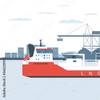A concept design for a new inland containership - dubbed Waterborne Container Carriers (WCC) - was completed and released by DeJong & Lebet, a project that was completed for Venture Capitol Investors LLC, which owns a patent on the concept.
Designed for operating on inland waterways, WCC measures 550 x 107 x 20 ft., with a length and beam specifically designed to fit in the Mississippi River System Locks. Air draft is limited to 42 ft. based on bridge height restrictions.
The full load draft of the vessel varies from nine ft., unballasted, to 12 ft. ballasted. The ballast is also used to maintain draft when the container load is light. The vessel's propulsion system has raising and lowering capability for shallow draft upper river operations.
The WCC is capable of carrying 566 40-ft. containers, or 1,132 TEU. The design can be modified to have some sections of the vessel set up for longer/higher boxes. The containers are stacked five high, with two levels in the hull and three levels above the main deck.
The vessel is designed to be powered by four Caterpillar 3606 diesels, 2,840 hp each at 1,000 rpm. The engines drive 360 degree Thrustmaster Z-drives, model 3000M, with type 19A nozzles, and stainless steel propellers. The vessel is designed to be operated with two engines only, when the power requirements are minimal. All Z-drives are designed for removal without drydocking. Engines are cooled using Alfa-Laval bolted plate heat exchangers.
The WCC features a pair of 550 hp bowthrusters by Schottel. The thrusters are powered by CAT 3406 E engines. Electrical power is provided by two 425 kW CAT 3412 gensets, one 170 kW CAT 3306 auxiliary genset.
The WCC is designed for U.S. Coast Guard Certification under Subchapter I. A preliminary manning analysis indicates a crew requirement of approximately 15. The vessel is designed with accommodations for 17, but could be easily expanded for 20 or more. The design also features a forward pilothouse and accommodation area, with aft machinery and engineering accommodations. A passageway in the hull connects he forward sections with the aft sections.
The vessel is designed to be constructed of welded steel. The design standard used is ABS Rules for Rivers and Intracoastal Waterways.
Sponsored Content
Innovative Hull Maintenance: Profitable & Green

Subscribe for
Maritime Reporter E-News
Maritime Reporter E-News is the maritime industry's largest circulation and most authoritative ENews Service, delivered to your Email five times per week













